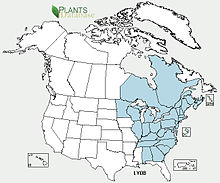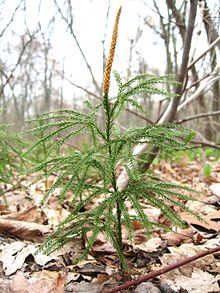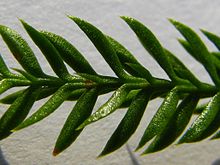- Lycopodium obscurum
-
Lycopodium obscurum A mature aerial shoot of L. obscurum Scientific classification Kingdom: Plantae Division: Lycopodiophyta Class: Lycopodiopsida Order: Lycopodiales Family: Lycopodiaceae Genus: Lycopodium Species: L. obscurum Binomial name Lycopodium obscurum
L.
Native range of L. obscurum. Species also allegedly introduced to Alaska[1]. Lycopodium obscurum, commonly called ground pine[2] or princess pine[3], is a species of clubmoss in the family Lycopodiaceae. It is a close relative of other treelike Lycopodium such as L. dendroideum and L. Hickeyi. It is distributed from Alabama to the east coast of the United States, and north into Canada. Newfoundland is in the northeast corner of its range. It grows in the understory of temperate coniferous and deciduous forests, where it is involved in seral secondary succession, growing in clonal colonies some years after disturbance has occurred[3].
Contents
Description
Lycopodium obscurum is known for the treelike appearance of its sporophyte, however its main stem is actually a subterranean, creeping rhizome, which grows about 6 cm below ground. Several aerial shoots branch off of the rhizome, which also branch dichotomously several times, giving L. obscurum its distinctive appearance. Fertile shoots possess sessile strobili, borne at the tops of their main axes and sometimes at the tips of dominant lateral branches. The leaves are microphylls, each containing only a single vein and measuring less than 1 cm long. Two types of microphylls are formed, green trophophylls that cover most of the aerial shoots, and yellow to tan sporophylls that form the strobili, and contain the sporangia. L. obscurum reproduces sexually via spores and also vegetatively, through its rhizome.
The gametophyte of L. obscurum is disc shaped prothallus[4], measuring an average of 1.5 cm[5]. It closely resembles other gametophytes of genus Lycopodium, so it cannot be identified by gametophyte alone. Doing so would be difficult nonetheless, as this type of gametophyte grows only underground, years after a disturbance has taken place[5]. Therefore, the compact soil caused by repeated human traffic would disturb these areas and L. obscurum spores would not germinate, and put pressure on living gametophyes and attached sporophytes.
Identification
Identifying L. obscurum in the wild can be difficult without prior study, because it is not only relatively rare, but shares much of its morphology with L. dendroideum and L. Hickeyi. However, it can be identified with the naked eye by observing its leaves. Below its first branch, the microphylls of L. obscurum are tightly packed to the axis, while those of L. dendroideum are fully spread down to the soil[6]. The leaves on lateral branches of L. dendroideum and L. Hickeyi are evenly shaped and distributed, while they are pressed into the horizontal plane in L. obscurum, with the underside leaves being much shorter than all others[6].
Growth Pattern
The rhizome of L. obscurum typically produces only one upright shoot per year and grows in a single direction[7]. In the beginning of a growing season, the rhizome grows a few centimeters and then forms one branch at a 90°, alternating sides each year, which remains only millimeters in length. It then grows another couple of centimeters and then again branches off to the same side to form an aerial shoot. The rhizome branch produced each year is usually very weak and dies the next, but sometimes becomes a new main rhizome[7]. This happens if the plant is especially productive, or more frequently if the tip of the main rhizome is damaged so that it cannot grow. When a new main rhizome is formed, it makes a second 90° turn so that it is growing in the same direction as the rhizome from which it came. All underground branching occurs parallel to the ground, so upright shoots must then orient themselves appropriately in order to emerge from the soil.[7]
Every year, a main rhizome produces one aerial shoot, but in the case of a plant with multiple main rhizomes a new shoot is produced from each[7]. The age of a shoot corresponds to the layers of compressed microphylls in its stem, caused by growth halting each winter, the same way as tree rings are formed. Shoot morphology can also be used to estimate their ages. First year shoots are unbranched and usually do not penetrate the soil surface. Second year shoots undergo rapid growth, usually reaching near their final heights, and forming several systems of lateral branches[7]. Branching occurs only in the second, and sometimes third years[6]. Strobili can be formed as early as the second growing season, but usually begin to be produced in the third. Strobilus production can continue through the fourth year, and shoots die in either the fourth or fifth year[6].
Uses and Conservation
Historically, L. obscurum has been harvested from the wild for use as Christmas greens for wreaths, as well as the use of its spores for flash powder. While flash powder is now practically obsolete, the harvest of L. obscurum has caused it to become threatened in several areas, leading Indiana[1] and New York[2] to declare it protected by state law. When harvesting legally, it is recommended to cut the shoots using shears to minimize rhizome damage, alternate sites every year, and select only individuals possessing stribili with open sporophylls[3]. This ensures that immature shoots are not harvested, and will be allowed an attempt at reproduction.
References
- ^ a b USDA, NRCS. 2011. The PLANTS Database. Lycopodium obscurum L. National Plant Data Center, Baton Rouge, LA 70874-4490 USA.
- ^ a b Department of Environmental Conservation. 2000. Protected native plants. Division of Land and Forests, New York.
- ^ a b c Nauertz, Elizabeth A. and Zasada, John C. 2000. Lycopodium: Growth Form, Morphology, and Sustainability of a Non-timber Forest Product. General Technical Report - North Central Research Station, USDA Forest Service. pp. 110-115.
- ^ Bruce, James G. and Beitel, Joseph M. 1979. A Community of Lycopodium Gametophytes in Michigan. American Fern Journal. 69:2. pp. 33-41.
- ^ a b Whittier, Dean P. 1977. Gametophytes of Lycopodium obscurum as grown in axenic culture. Canadian Journal of Botany. 55. pp. 563-567.
- ^ a b c d Hickey, R. James. 1977. The Lycopodium obscurum Complex in North America. American Fern Journal. 67:2. pp. 45-48.
- ^ a b c d e Primack, Richard B. 1973. Growth Patterns of Five Species of Lycopodium. American Fern Journal. 63:1. pp. 3-7.
Categories:
Wikimedia Foundation. 2010.



